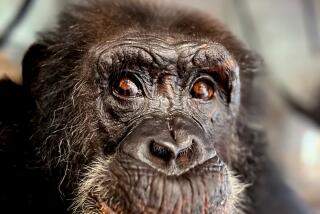Chimps Turning Into Real Chatterboxes : Research: Sign-language project could help autistic children learn to communicate.
ELLENSBURG, Wash. — One chimp asks for milk. Another organizes a game of chase. Later, chimps open a package of toys sent by admirers.
This isn’t a “Planet of the Apes” movie.
It’s the Chimpanzee & Human Communication Institute, a research project that is teaching five chimps to speak in sign language.
Director Roger Fouts, a Central Washington University psychology professor, says the research can yield data in how animals think. The work is also useful in teaching communication skills to autistic children.
“With the chimps, we observe and adapt our interests to them,” Fouts says. “With autistic children, we do the same thing: observe, and see what grabs and gets their attention.”
Right now we have the attention of Washoe, 27, who comes right up to the protective glass to peer at a visitor.
“This is the first of its kind in terms of language,” Fouts says of Washoe, who began learning sign language in 1966 and is considered the first non-human animal to acquire a human language.
Washoe was reared as if she were a deaf child by scientists at the University of Nevada, where Fouts was a graduate student when he met the chimp in 1967.
The scientists realized that chimpanzees in the wild communicate more with gestures than voices. Washoe was taught to use American Sign Language in dealing with humans. Three other chimps, Moja, Dar and Tatu, were taught in a similar fashion.
The youngest chimp, Loulis, was reared by Washoe in an experiment to see if an animal could acquire a human language from another animal.
Humans were not allowed to sign around Loulis from 1979 to 1984, when it was verified that the chimp was signing.
Verification occurs when a sign is recorded by three observers for 15 consecutive days.
Fouts and his wife, Debbi, co-director of the institute, moved the chimps to the University of Oklahoma in 1970. In 1980 they decided to seek better facilities by moving to Central Washington University in this small town 100 miles east of Seattle.
Do the chimps really talk in sign language?
Some critics have contended that the signs just imitate what the researchers are doing and are not logical.
Many of the gestures do appear to be little more than hand and finger movements, interpreted by the researchers.
But the Foutses contend that their videotapes of the chimps signing to each other, when humans are not around, prove that the animals can communicate.
Not that the conversations are terribly complex. Washoe, the most accomplished, has a vocabulary of about 240 words, the Foutses say.
Much of the signing is single-word commands, like chase, gum, out, person, hurry and flower.
In talking to the chimps, the Foutses have found that body language such as head bobs, bent arms with open palms and smiling without exposing teeth help get the message across. The flash of teeth is viewed as a threat by the chimps.
It can seem odd that a screaming, spitting chimpanzee pounding on inch-thick bulletproof glass is a tool that could help autistic children.
But autistic and other non-communicative children also may learn differently, in the same way the chimps do, the Foutses say.
The key is to look at what individual autistic children seek and what they avoid, then to try to adapt communication based on that behavior, they say.
Because it is a research project, the chimps’ home is not regularly open to the public.
But the institute runs regular “chimposiums,” when visitors pay $15 to hear lectures on the chimps and then to observe them. The two-hour sessions are one way the Foutses raise money to care for the animals.
It costs $200,000 a year to maintain the chimps and the research. None of that money comes from the state. Rather, it comes from foundations, donations and other fund-raising devices. The Foutses acknowledge that money has become a problem.
Perhaps the best ambassadors are the chimps themselves, whether they are swinging from ropes in their play area, climbing across the ceiling of the building or signing to groups of visitors.
The chimps also appear to talk to themselves in sign language, the Foutses say.
The chimps eat the same thing the humans eat, Fouts says. This day they lunched on lentil soup, using spoons and bowls.
The animals typically react to new students and attendants by spitting at them and displaying raw aggression, Fouts says.
The young males seem to respond best to attractive human females and sometimes view human males with hostility, Fouts says.
The animals are enjoying a new $2.3-million home, funded by the Legislature, that includes a 32-foot-tall outdoor area for swinging and climbing. It opened this summer.
For 13 years the chimps shared just 300 square feet of living space on the third floor of the school’s psychology building.
Their new home is 7,000 square feet; it includes sleeping cages, a kitchen and laundry facilities for the clothes they sometimes wear.
It has allowed them to live outside for the first time in 13 years. As a result, some suffered from sunburn in the first weeks.
Researchers take pains to vary the chimps’ diet, play games, read books and converse with the animals to keep them stimulated.
Hanging on the building’s walls are paintings by the chimps. They are non-representational splashes of color that resemble the works of preschoolers--or some adult artists.
The building also has air conditioning, a luxury that was recently denied at the state-owned home of Central Washington University President Ivory Nelson after students protested the cost.
Fouts says the chimps deserve the comfortable quarters.
“They didn’t volunteer to come here,” he says. “They are incarcerated. We have an obligation to do the best we can for them.”
More to Read
Sign up for Essential California
The most important California stories and recommendations in your inbox every morning.
You may occasionally receive promotional content from the Los Angeles Times.










